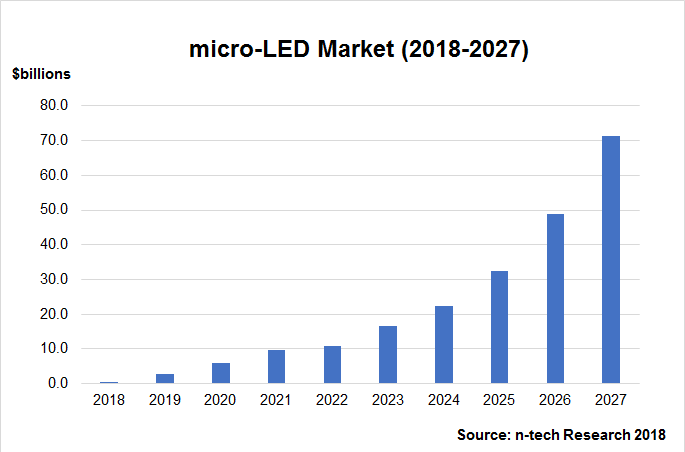A company called N-TechResearch sent us through its forecast for microLED technology and the firm said that it expected revenues of $10.7 billion by 2022, but then with revenues rising to over $70 billion by 2027. We were intrigued with this forecast and spoke to the analyst that made the research, Dr Boris Kobrin (a thirty year veteran in semiconductors, optics, equipment and MEMs) about the reasons for the large numbers and the potential hurdles that the company expects to see. N-Tech Research is a specialist in nano-technology research.
One of the key reasons that N-Tech has a big forecast is that its forecast takes into account a number of non-display applications including medicine and healthcare as well as LiFi (networking using LEDs as the transmitters) as well as lighting. However, Kobrin told us that it expects the early applications to be in display, in two to three years, with other applications coming along in three to five years and onwards.
In displays, Kobrin believes the two clear and early opportunities are for very small displays for near-to-eye (NTE) applications including AR as well other applications using small imagers and needing high brightness such as HUDs and for larger displays, beyond the range that can come from LCD at around 100″. The opportunity for larger displays, as we have reported a number of times, is largely because the cost scales with the number of the pixels rather than just with area. That means that for a given resolution, the cost doesn’t rise hugely if you make the display bigger – unlike LCD and OLED, where cost scales with area.
MicroLED displays can also be made flexible and transparent and that will allow new applications.

One of the topics we spoke about is the bulk transfer schemes that are being developed and Kobrin told us that he believes the successful technologies will depend on ‘external forces’ such as using lasers. Another challenge will be the uniformity, but Kobrin’s contacts in the epitaxy side have convinced him that new equipment being developed can significantly improve the uniformity of the epitaxy, improving the device uniformity to be much better than current LEDs. Companies such as Aixtron are also looking at being able to make high quality and highly uniform microLEDs on 8″ wafers – which will be essential for volume applications, as will ‘in-situ’ testing to deal with defective die.
Of course, there is still work to be done to decide which LED architecture is the best. Kobrin told us that his personal favourite would be nanowire-based LEDs because they can be grown in all three colours and have no issues with efficiency drop with die dimension. However blue LED plus quantum dots should have an advantage in yield and cost if QD lifetime issues can be overcome. On the other hand, ‘traditional’ LED technology might be ‘good enough’. That means that it is likely that all three will have a place in the development of the microLED market.

